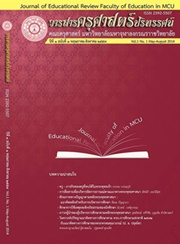The Communication for Emotional Management in the Buddhist Aspect
Main Article Content
Abstract
In the Buddhist perspective, the word “emotion” refers to “āramana” in
the Pali language which means stimuli through one’s eyes, ears, nose, tongue, body
and mind. These āramanas can be managed by intrapersonal communication and
interpersonal communication. The benefits of the communication for emotional
management in the Buddhist perspective are for oneself and others. The first one
was self-control and mental development. The second one was shown in the
positive interaction among one another and in living together with happiness. The
way of communication for emotional management in the Buddhist perspective
combined both the way of thinking and practice together which exhibited in
intrapersonal communication and interpersonal communication? The way of thinking
based on the principle of Kamma and the Three Common Characteristics. The keypractice was based on Sense-Restraint, mindfulness cultivation and Supreme Efforts
Article Details
ทัศนะและความคิดเห็นที่ปรากฏในบทความในวารสารฉบับนี้ถือเป็นความรับผิดชอบของผู้เขียนบทความนั้นเพียงผู้เดียว และไม่ถือเป็นทัศนะและความรับผิดชอบของกองบรรณาธิการ
กองบรรณาธิการขอสงวนสิทธิ์ในการคัดเลือกบทความลงตีพิมพ์และจะแจ้งให้เจ้าของบทความทราบหลังจากผู้ประเมินบทความตรวจอ่านบทความแล้ว
ต้นฉบับที่ได้รับการตีพิมพ์ในวารสารครุศาสตร์ปริทรรศน์ คณะครุศาสตร์ มหาวิทยาลัยมหาจุฬาลงกรณราชวิทยาลัย ถือเป็นกรรมสิทธิ์ของคณะครุศาสตร์ มหาวิทยาลัยมหาจุฬาลงกรณราชวิทยาลัย ห้ามนำข้อความทั้งหมดหรือบางส่วนไปพิมพ์ซ้ำ เว้นเสียแต่ว่าจะได้รับอนุญาตจากมหาวิทยาลัยฯ เป็นลายลักษณ์อักษร


